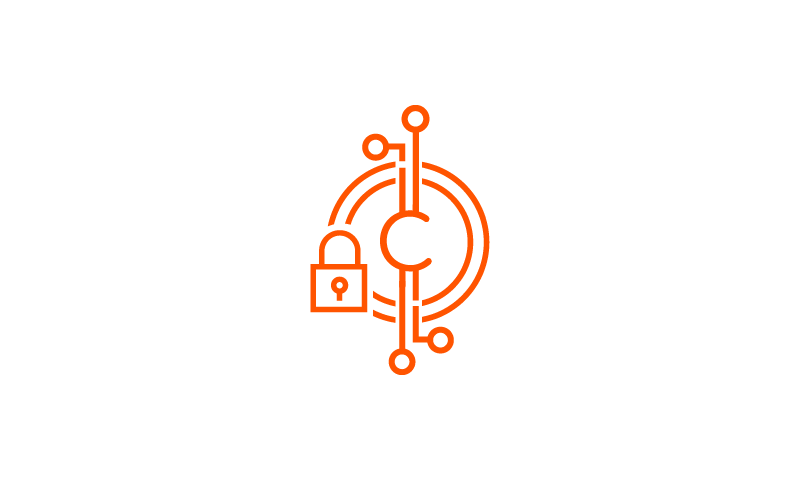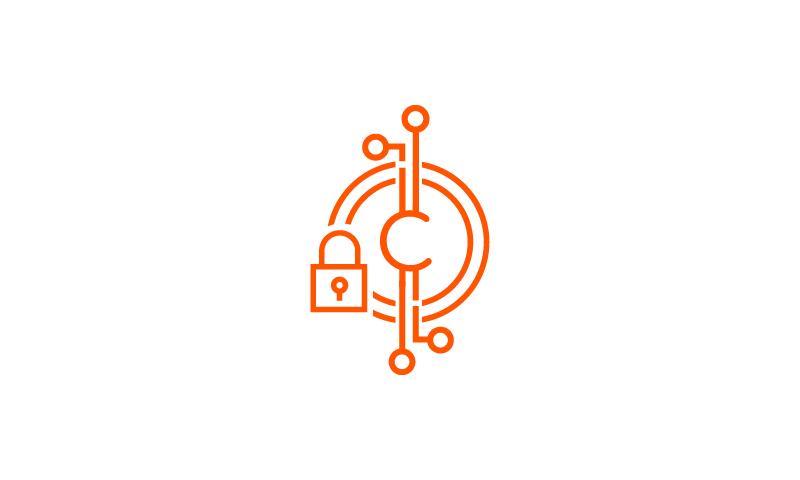Permissionless 2022 Conference: A Recap of the Major Takeaways
Editor’s Note: Please see the glossary at the end for all terms highlighted in sea green found in the order that they appear.
Recently, our team got the opportunity to attend Permissionless, a Web3 conference hosted by Blockworks and Bankless, in Palm Beach, Florida. The conference was a fantastic showcase for some of the rapid changes occurring within the digital assets space, and its role as a technological disruptor to tomorrow’s infrastructure.
Regardless of price action and market conditions, projects and developers keep on building, users keep transacting, advocates are further onboarded, and value is being created. Our conviction was refreshed, and we could not be more excited about what is to come in the times ahead.
Key Takeaways:
- The industry is focused on greater adoption and protection, aiming for improved and safer infrastructure for users to benefit from.
- Projects and builders keep innovating and developing novel applications for a Web3 economy including a new financial, creative, and social infrastructure.
- Capital is flowing to the market and institutions have arrived in force. A market predominantly led by retail participants has now garnished strong attention from large entities as they discover the core values and creative applications of digital assets today.
- Scalability is a core focus for developers. Being able to absorb existing and incoming demand is what will help digital assets become a greater global ecosystem. The space is working on a plethora of options ranging in functionality to tailor for specific transaction needs.
An Event Tailored Towards a Web3 Movement
The interest in this conference is indicative of how far the industry has come. What immediately caught our eye was the total attendance and its diverse group of participants spanning digital assets enthusiasts all the way to institutional investors. The layout of the event was very well thought of as well, featuring the main stage with a sea of rows and an impactful screen, various theme-focused side stages, a convention area where multiple companies showcased their diverse offerings, and even a digital art NFT (non-fungible token) gallery. With over 5,000 digital asset enthusiasts present at the event, the atmosphere was filled with an electric eagerness to build and carve a path towards a Web3 infrastructure.
In order to understand the significance of our key takeaways, we must first explain what Web3 aims to achieve. Web3 is a shift from a centralized web to a global decentralized infrastructure where data and content is stored, accessed, and owned via the attributes of distributed ledgers. The ability to program applications into these distributed ecosystems allows builders to construct a decentralized web that aims to improve many traditional sectors today and promote a collaborative and transparent network. Anyone with an internet connection will be able to access these permissionless and rich ecosystems, creating a new digital world.
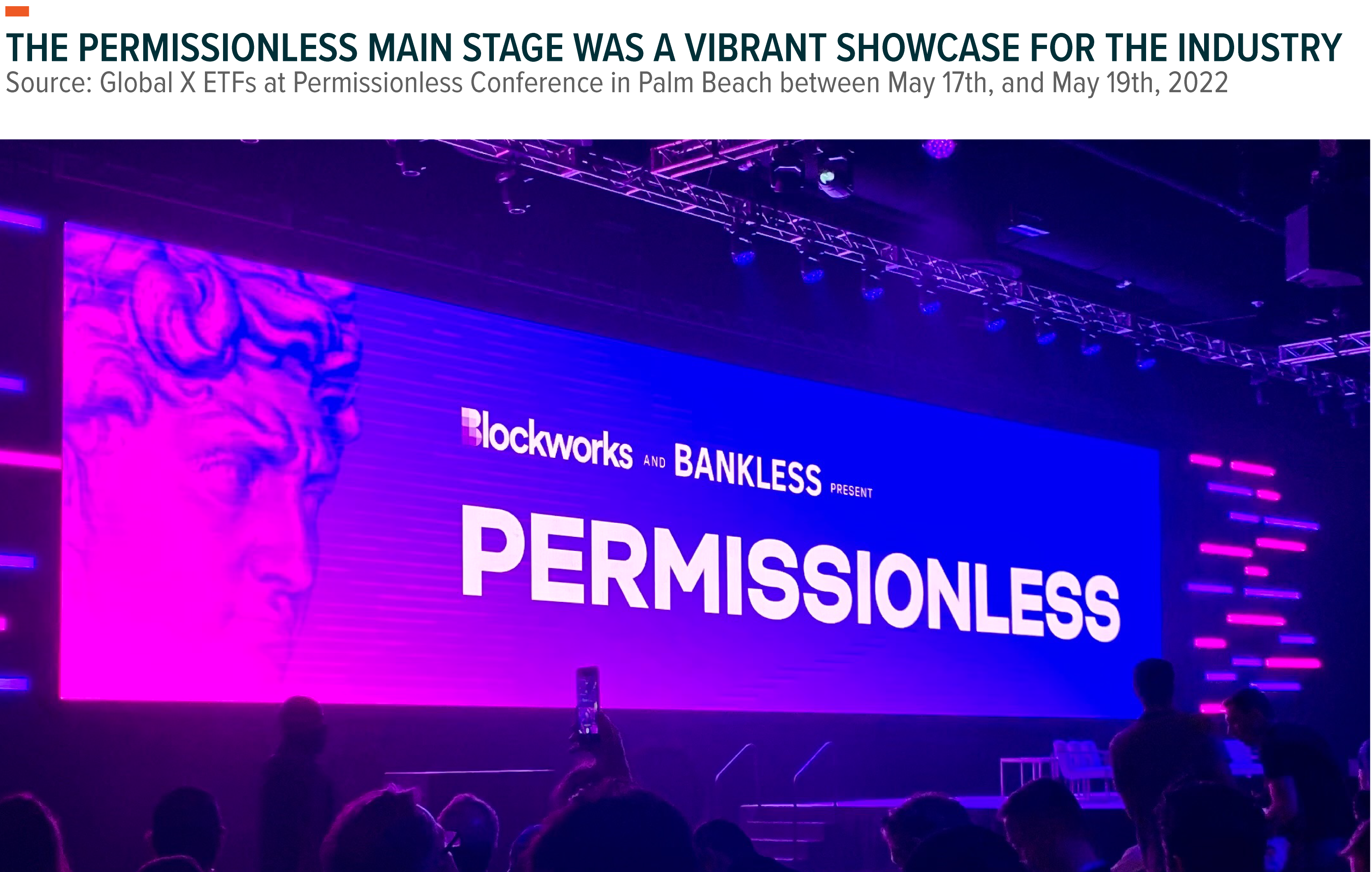
Building a Better and Safer Collaborative Infrastructure that Onboards the Next Wave of Users
To kick things off, Coinbase, a leading centralized exchange, revealed its intention to onboard the next wave of users. They are attempting to do so by creating a wallet that provides easier fiat on-ramps, self-custody innovations, and access to decentralized finance (DeFi). The non-custodial wallet introduces a novel approach to private key management where users will be able to split their keys with Coinbase, allowing for a mix of self-custody and protection.
Builders have recognized the importance of a proper infrastructure by which users can safely transact and engage with Web3 applications. There was a significant amount of focus on how the industry provides easier and safer access to users while also calling for insurance developments within the space. This ultimately allows for an improved user experience with novel infrastructure in wallet technology, collaborations, and customer support.
Robinhood entered the playing field as well by announcing a new digital and non-custodial Web3 wallet; allowing users to hold their keys, engage with DeFi (decentralized finance) applications, store NFTs, and trade without network fees.
While the underlying mechanisms have yet to be revealed, this announcement backs an important topic of discussion within the conference: the collaboration between fintech and DeFi.
Generally, Web2 fintech platforms offer an onboarded pool of users, customer support, and simple UX design, which sets the ground for a hybrid approach. This collaborative approach between fintech and DeFi fulfills a better finance experience backed by the innovations of smart contract applications as the infrastructure layer. Of course, the Bankless team, a prominent digital asset community, has a name for this approach. They call it the DeFi mullet. Today, Web2 users care about capital efficiency, speed, safety, and proper support. The DeFi mullet thesis can serve as the gateway to further onboard these users into a Web3 infrastructure.
More established Web3 wallet providers such as Ledger shared Coinbase and Robinhood’s vision of providing greater tools to enhance user support and adoption. Ledger, a cold storage wallet producer, announced Ledger Connect, an added web extension with novel safety features linked to their cold storage hardware offerings. Ledger Connect will serve as the bridge between strong security traits, due to Ledger’s ability to store private keys offline, and the interaction with web-based dapps (decentralized applications) , all within the Ledger ecosystem. What is interesting is that they will include intelligent safety checks for user protection such as providing address and contract insights prior to executing transactions. This is important because today there are no safety checks in non-custodial wallets. This means that if users incorrectly submit a transaction, there is nothing in place to serve as a warning barrier. Within Ledger’s web extension, users will be able to see safety precautions and alerts depending on their activity, adding a novel layer of security and protection.
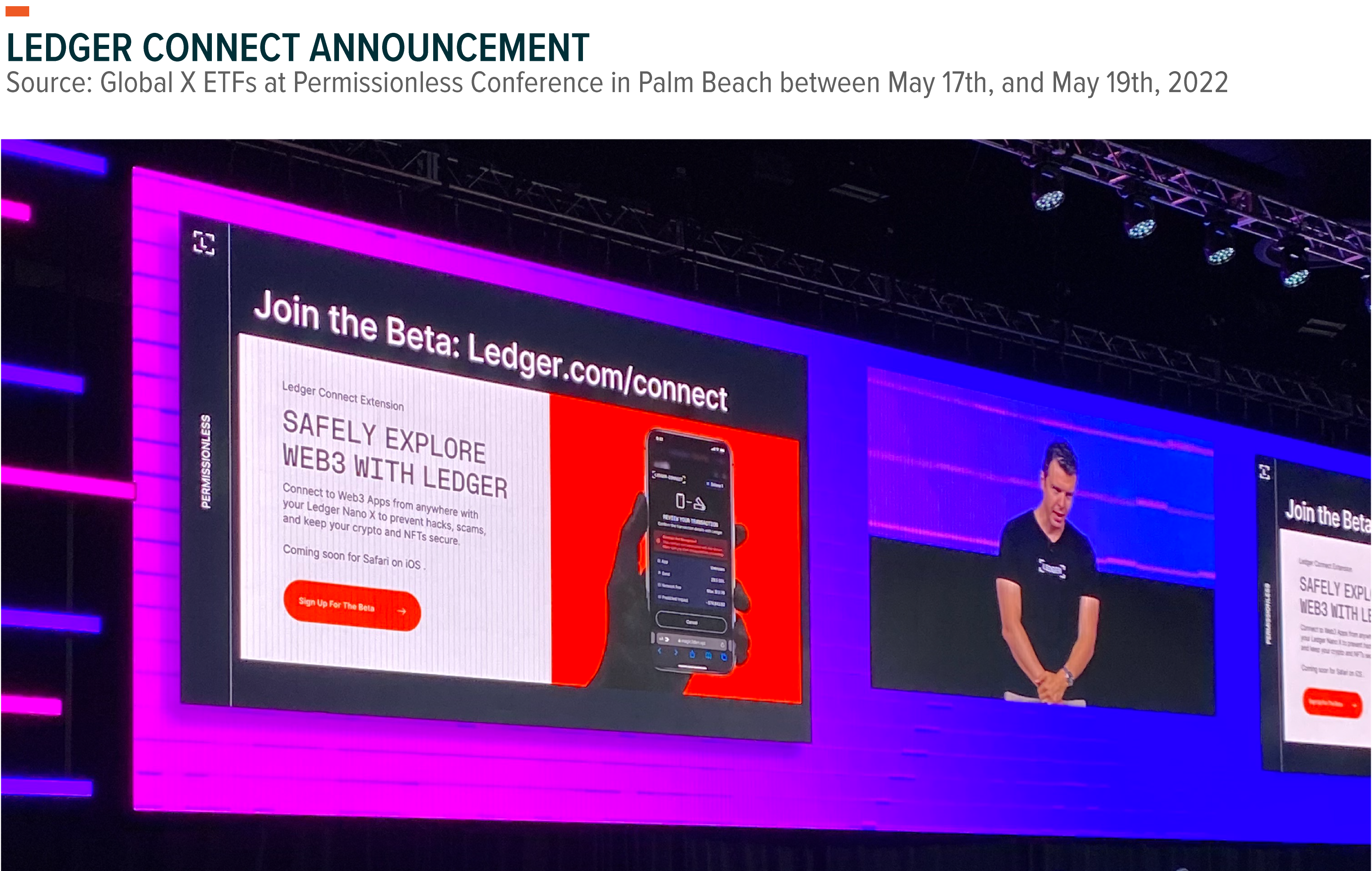
To wrap up the user-protection theme, Consensys, a leader in blockchain development and innovation, announced a collaboration with LivePerson to create Village DAO. The mission is to provide a framework for improved customer protection with an initial blueprint for Web3 customer service, using Metamask as the pilot wallet extension. Today, many dapps operate without a central customer service team, and this poses a challenge for users seeking technical aid if and when needed. The DAO (decentralized autonomous organization) aims to provide a decentralized customer care community that supports the growing needs of a new web3 infrastructure.
The Rise of Social Web3 & A New Creator Economy
It is safe to say that Permissionless served as a hub for a Web3 social movement. A strong ethos revolved around providing power to communities and creators via Web3 applications and its ability to frame the future of our digital infrastructure.
Brands and content creators with communities must tap into the social developments Web3 provides. Because of the advantages of digital assets, creators are transforming relationships and providing improved access and power to their communities. In Web2, creators build an audience to then monetize via alternative methods. With Web3, creators can monetize their work and from such work, bootstrap an engaged community of users and advocates with improved relationships, value drivers, content ownership, and enhanced experiences.
Social crypto tokens are being built to establish an online identity. Projects like Disco.xyz, led by Evin McMullen, are building the base layer for proper digital identity. Think of it as a digital backpack, and such a backpack builds over time to include attachments that define your persona based on real-world and digital interactions. This digital identity will allow users to experience a new form of social engagement. While still early, the project has a lot of potential and we cannot wait to see what the team has in store.
Prominent DeFi platform Aave also planted seeds toward a decentralized social infrastructure. Why is this important? Today users seek privacy and ownership of both data and content, and community fostering requires improved tools. This has led projects to develop Web3 alternatives to the current centralized social platforms. Through a project called Lens, the Aave team showcased the first foundation for a decentralized social platform through Polygon, an Ethereum scaling solution. Lens provides a composable graph and framework that allows developers to build social applications within their ecosystem. One of the first applications showcased is called Lenster and it serves as an open-source social network similar to Twitter.
A user’s Lens account is composable with every application built, thus allowing the ability to carry their data, content, audience, and overall history across the Lens ecosystem. User profiles are stored as NFTs and all social interactions are signed into the blockchain, allowing users to gain permissionless and non-custodial control of data and content.
David Hoffman, Bankless’ co-owner, and Stani Kulechov, founder and CEO of Aave, jumped on stage and gave a powerful presentation on Len’s mechanism and features. During their presentation, we got to witness how users create these decentralized profiles, set rules around follower conditions including whether or not other users should pay to follow, and a plethora of other neat features such as the signing of interactions on-chain.
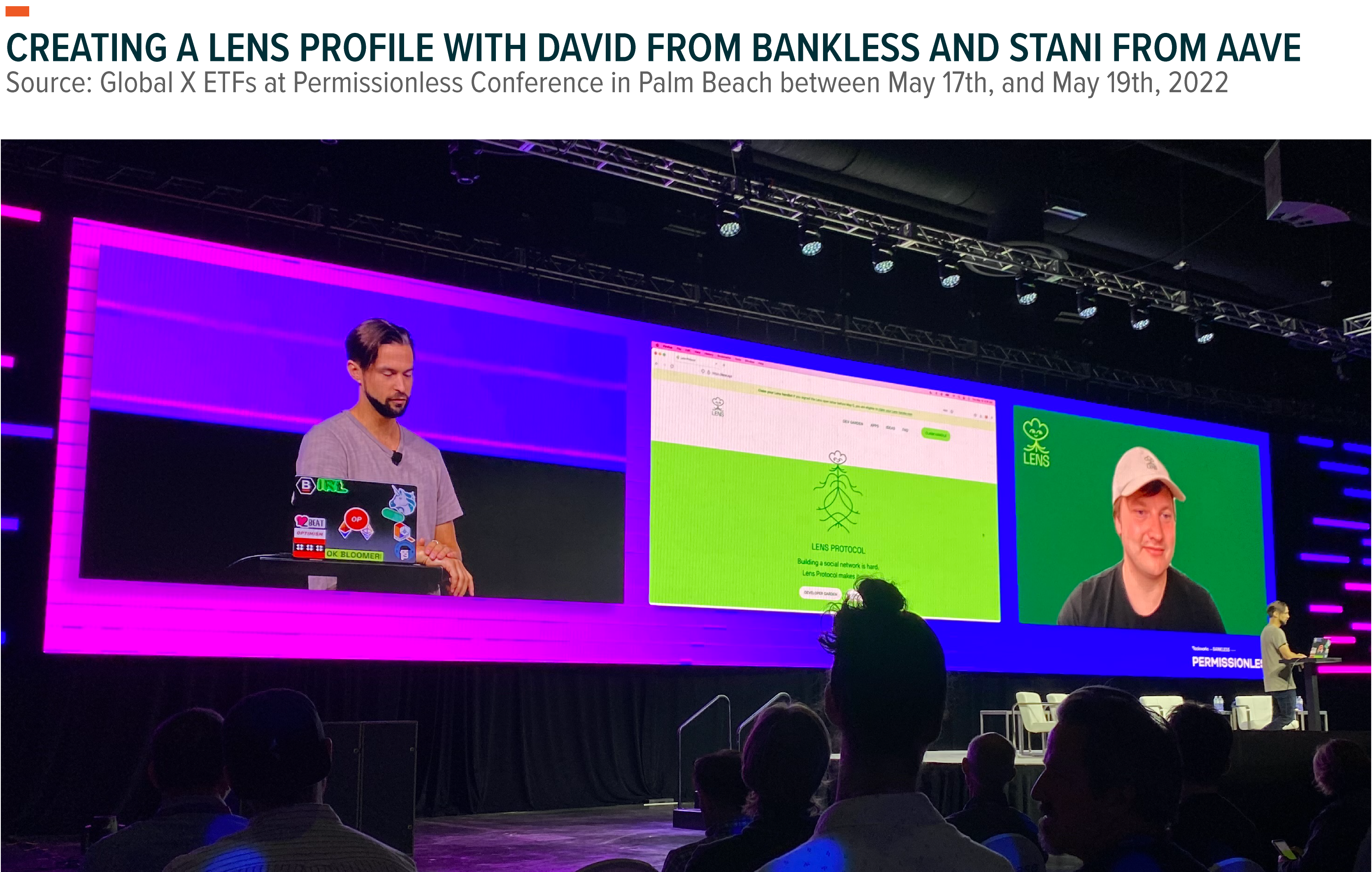
A movement has begun with power to creators and communities as the core motif, and we expect plenty of developments in the months to come. Within such a massive space, brands, creators, and users have the ability to own and control the value of their content while improving on community experience.
Institutional Interest is High, Participation is Strong, and Funds Keep Allocating to Digital Asset Developments
The amount of deployable money via venture capital, the presence of alternative digital asset funds, and institutional interest were greatly felt at the event. Regardless of current conditions, investors are optimistic about the disruptive potential of this technology and this is why prominent venture capital firms are ready to deploy capital. For instance, Andreessen Horowitz (a16z) launched the largest dedicated digital asset fund with $4.5 billion aimed at Web3 growth.
Institutions further understand the value proposition the space provides and are allocating mind space, resources, and time as well. They are becoming increasingly bullish about projects like Ethereum, as ETH transitions into a yield-generating, potentially deflating asset with high demand. The excitement was felt when Ethereum core developers Preston van Loon and Justin Drake stated that the merge, Ethereum’s transition from Proof-of-work (PoW) to Proof-of-stake (PoS), will likely take place during August of this year.
While there were plenty of talks about Ethereum, institutions are also expanding to alternative smart contract platforms and buckets like DeFi, gaming, and the creator economy, where immense value and utility are being built due to digital asset’s core attributes.
Because of this expansion of interest, builders are creating new tools via which these large entities can leverage the developments within areas such as DeFi.
To further support institutional infrastructure and its specific requirements, Coinbase’s cloud division, in partnership with Figment, a liquid staking firm, announced that it would provide support for a new project called Alluvial. Alluvial serves as the first institutional level liquid staking protocol and seeks to fulfill such demand while simultaneously addressing the compliance and security standards required.
Liquid staking is an improvement to traditional staking, where users lock their assets in exchange for yield generated by securing the network and validating transactions. Liquid staking allows users to receive a tokenized receipt in exchange for their staked assets. These tokens can serve as liquid tokens for other transactions including further engaging in DeFi applications, unlocking liquidity, and increasing capital efficiency.
This is a massive move for the space and further moves the needle for the new wave of DeFi, which includes solutions to liquidity constraints by offering innovative yield solutions and facilitating improved and liquid DeFi engagement.
Scaling Blockchains to Meet Demand
There is an increasing demand for block space due to the constant innovations and application utility within the space. This triggers a movement for developers to build platforms that are able to securely host such demand for transactions at user-friendly costs without sacrificing decentralization. There are generally two schools of thought: those who are building alternative and secure blockchains with scalability features and those who are working on options to scale Ethereum as a network due to its value and power today.
Projects such as Avalanche and Near are working on innovative smart contract blockchains that offer both horizontal and vertical scaling solutions through a single network without compromising security and transaction settlement finality.
On the other hand, those developers who believe Ethereum should become the superchain of the future, especially after its transition to PoS, are building scaling solutions that extend Ethereum’s throughout to another layer. These layer extensions are called layer 2 solutions , with projects such as Polygon, Optimism, Arbitrum, and ZKsync working on this technology. The general idea behind these layer 2 solutions is to group and validate transactions through various mechanisms on an alternative layer and settle such transactions as a bundle within Ethereum’s main layer at some point in time. This allows for the expansion in the availability of transactional options tailored to the user’s needs.
Now, why are these projects trying to scale Ethereum? Ethereum can only process a certain number of transactions per block due to block times and sizes. These rules around block constructions allow for the network to be secure and decentralized but at the cost of scalability and throughput. Because of its immense network of applications and utility, block space demand has increased transaction costs and makes Ethereum’s network expensive for some. Due to these scalability constraints, developers are working on alternative options within such a rich and established ecosystem.
Many of the key players working on these solutions were present at Permissionless. And while there are differences in thought process and technicality, both schools of thought agree that a range of scalability options are needed to absorb the incoming and expected demand. Additionally, panelists seem to agree on the adoption of zero-knowledge proofs as a way to unify and promote interoperability across all these ideas. What is evident is that there is a great pool of developers working on novel ideas and applications are taking advantage of the various options offered.
With scalability and blockchain interoperability in mind, it’s safe to say that the space will continue to evolve as time goes by.
Thought Leaders Provided a Deep Dive into The Space
Permissionless served as an inner brainstorming exercise due to the content, perspectives, and knowledge shared on stage. Below we cover some of the most important thoughts shared:
Web3 Changes the Creator Economy
We were greeted by a great research piece from the team over at a16z. The essence of such discussion revolved around the current creative and innovation cycle within digital assets. Today, creators generally rely on alternative sources of monetization due to the lack of financial incentives via Web2 platforms such as Twitter and Instagram.
The report illustrates the importance of Web3 to the creator economy, as it offers greater economic terms and ownership to communities and creators; being able to own their data and explore direct monetization strategies. Web3 is making a massive impact on the creator world and there is a lot of untapped potential.
MEV Extraction Needs to be Understood and Addressed
We found really interesting the MEV discussion and its importance. For those unaware, MEV (maximal extractable value) , refers to the value of information that can be extracted from being able to build blocks and accessing submitted pending transactions. Generally speaking, when users submit transactions into a blockchain, these transactions remain in a pending state until included in a validated block . Because transactions generally go through this process flow, block producers have access to valuable information by which they can identify arbitrage opportunities and front-run transactions for economic benefit. The Flashbots team did a great job comparing MEV with traditional tactics such as market-making and payment for order flow.
MEV is an important topic as it enhances economic benefits from block construction, thus Flashbots is working on a concept called MEV Boost tailored towards Ethereum’s upcoming transition to PoS. MEV Boost allows Ethereum validators to outsource block construction to a network of block builders, creating a marketplace of participants competing to produce blocks with the most value, and providing greater staking yield for validators.
Developers Are Working to Bring Awesome Games On-Chain
Gaming is one of the areas that exploded in popularity in 2021. One of the primary growth reasons is the value proposition that tokenized in-game economies pose, as users can receive fungible or non-fungible tokens from playing games, hence monetizing their gaming time. The problem with on-chain games is that generally, they are not that fun to play.
Games like Illuvium and platforms like Gala Games are solving this issue and are poised to revolutionize gaming deployment through distributed ledgers by building an exciting game with a great community behind it. While gaming has significant hurdles to solve, both Web2 and Web3 developers are working behind the scenes to provide users with games worth playing within a new digital and economic framework.
A Potential Next Wave of Growth through NFTs
The intersection between NFTs and DeFi was a strong talking point present at the event. This is due to the fact that DeFi provides a liquid vehicle for both digital and real-world assets that would otherwise never exist. These include lending and borrowing protocols for any digitalized asset.
There was significant chatter around Ethereum’s ERC-721 standard and how it can potentially trigger the next wave of NFT adoption. ERC stands for “Ethereum request for comment” and is a mechanism by which developers can create and agree on token standards.
For those unfamiliar, ERC-721 is a non-fungible token set of rules that allows users to uniquely tokenize and represent assets such as any digital or real-world good. Unlike the ERC-1155 where tokens can be both semi-fungible and non-fungible, these tokens are unique and are explicitly non-fungible. The ability to tokenize unique real-world assets adds liquidity, novel concepts, and new avenues of exploration as it pertains to ownership and value transfer. Assets such as house deed, artwork, collectibles, contracts, and any valuable good can be tokenized and brought on-chain .
The Outlook for Stablecoins
Naturally, there was a lot of talk about UST’s collapse and algorithmic stablecoins. Nic Carter, a partner at Castle Island Ventures and co-founder of Coinmetrics, offered the audience reflectful thoughts about UST. Notably, he stated that UST’s algorithmic mechanism, in hindsight, was not really reflective of a true stablecoin due to its financial engineering, but mentioned that he still has hopes for a truly decentralized stablecoin because of their native ethos around composability, autonomy, and privacy. Sam MacPherson, a lead developer at MakerDAO, and Sam Kazemian, founder of Frax Finance, highlighted the idea of collateralizing stablecoins with real-world assets; illustrating that the stablecoin market is working on innovative ways to move the concept forward. Overall algorithmic stablecoins and the general concept have a long hill to climb and it remains to be seen how the market develops and grows from the recent events. What is evident is that stablecoins need strong backing in order to remain, well, stable.
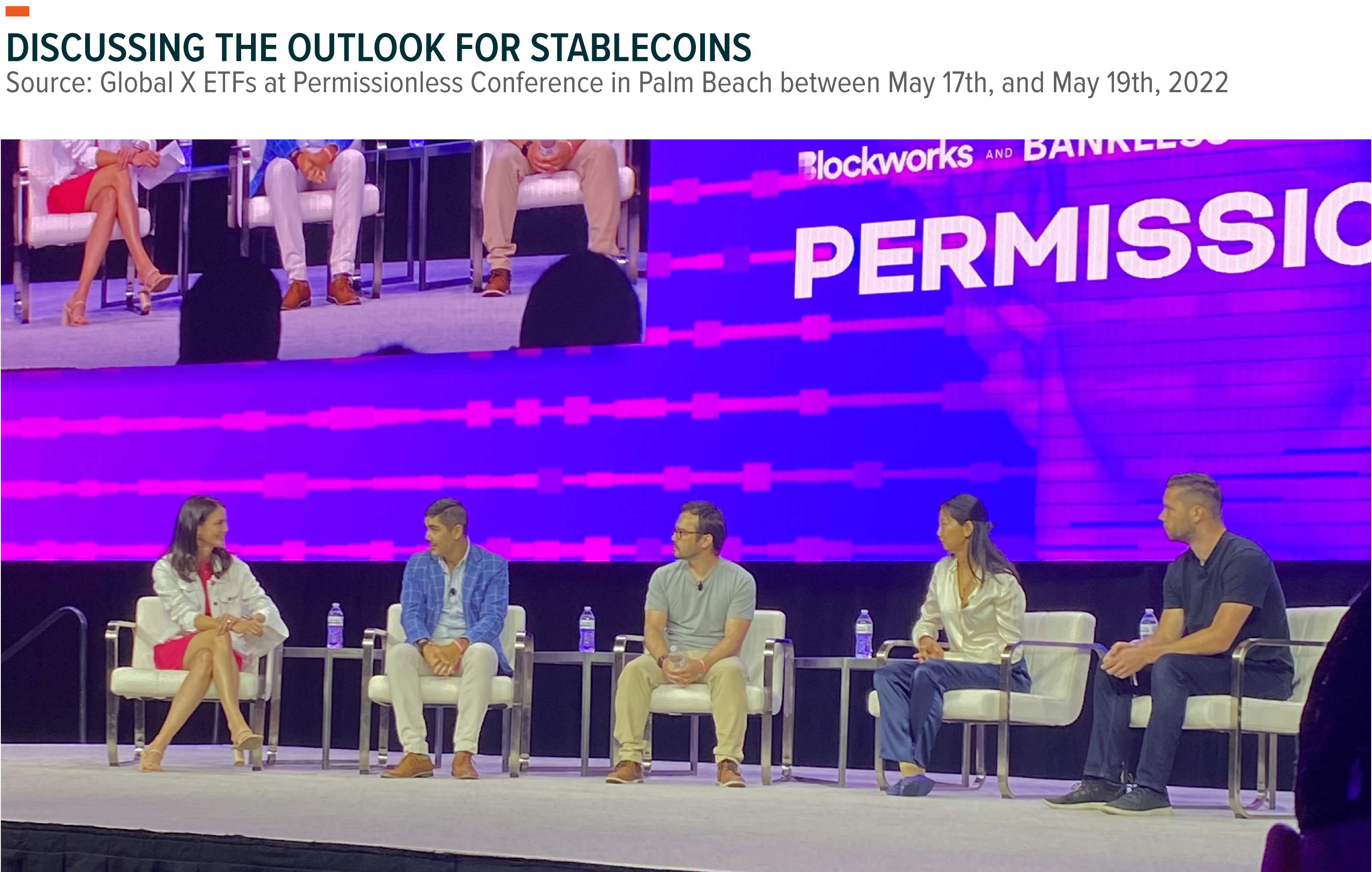
Regardless of Price Action, Builders Build, and the Community is Our Strongest Asset
We feel a sense of relief and excitement greatly due to all the developments happening regardless of asset prices, but also because of our amazing community. It is great to see that a space that used to be governed by retail users has garnished a lot of institutional interest and new participants, and this was evident at the event. Every participant is building, advocating, and growing the community. We could sense the eagerness to continue building towards a better future. We are early and the infrastructure will continue to evolve as the space matures. There is a one-way shift of talent from traditional sectors into Web3, and this is perhaps the strongest asset we have today, the builders within our community and the people involved within this space.
To the Blockworks, Bankless, and Coinbase team, thank you and see you next year.
